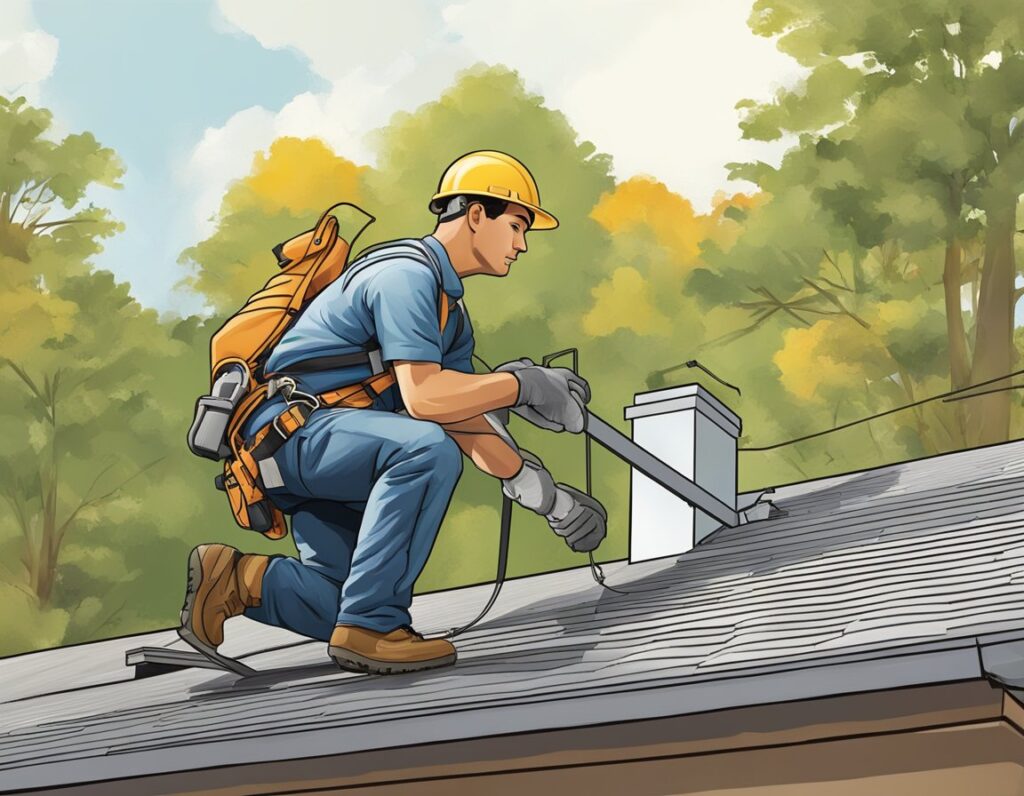Roofing work is inherently hazardous, with tradespeople contending with lofty heights and a unique set of safety challenges.
Recognising these risks, safety signage plays a pivotal role in mitigating accidents on construction sites.
By clearly conveying crucial information through illustrated signs, roofers can be constantly reminded of the dangers and the necessary precautions to take.
These visual aids are not just a mere suggestion but serve as a vital tool for communication, keeping safety protocols at the forefront of every worker’s mind.

Illustrated safety signs speak a universal language that cuts through literacy and language barriers, offering an immediate understanding of the potential hazards.
Their use in the roofing industry is essential, guiding roofers through daily tasks while alerting them to possible risks.
Whether it’s indicating the appropriate personal protective equipment to be worn, highlighting restricted areas, or illustrating potential hazards like falls or electrical risks, these signs are an integral component of a comprehensive safety strategy.
Key Takeaways
- Visual safety signs are crucial for conveying safety information to roofers.
- Signage helps prevent accidents by alerting to hazards and necessary precautions.
- Effective safety signs are an essential part of a roofer’s safety measures.
Significance of Safety Signage
Safety signage is an integral part of maintaining a safe roofing worksite. It keeps you informed and protected from potential hazards.
Compliance with Safety Regulations
In the UK, you’re required to comply with the Health and Safety (Safety Signs and Signals) Regulations 1996.
This ensures that safety signs are present where risks cannot be avoided or adequately reduced.
Signs must be clear, legible, and well-maintained to provide consistent messaging about safety precautions, which include:
- Mandatory signs: Such as wearing a hard hat on site.
- Prohibition signs: For instance, no entry to unauthorised personnel.
- Warning signs: Like alerting to the risk of falls.
Visual Alerting Systems
Your safety is enhanced by visual alerting systems that signal potential dangers from a distance.
High-visibility signage helps you to:
- Notice hazards: Such as exposed edges or slippery surfaces.
- Follow safe paths: Indicating walkways and access points.
PPE and Equipment Labels
Signs indicating the necessary Personal Protective Equipment (PPE) are vital on your site. Here’s what you should look for:
- Signs specifying head protection: Marked with a helmet symbol.
- Labels on equipment: Detailing proper usage to prevent accidents.
Fall Prevention and Protection
Roofing involves working at height, where falls are a major risk.
Safety signs play a key role in fall prevention by:
- Marking restricted areas: Where there is a risk of falling.
- Highlighting safety features: Such as guardrail locations and anchor points.
Hazard Identification and Risk Assessment
Each sign serves as a daily reminder of the hazards present and the control measures you should follow.
Effective signage contributes to:
- Hazard identification: Alerting you to risks like fragile surfaces.
- Risk assessment: Reinforcing the importance of assessing your surroundings.
Illustrating Effective Safety Signs for Roofers

Effective safety signage for roofers is a critical component in preventing accidents. These signs serve as constant reminders of potential hazards and necessary precautions.
Signage Visibility and Readability
Your safety signage must be highly visible and easily readable, even from a distance.
Opt for large fonts and contrasting colours to ensure messages stand out. For instance:
- Font size: At least 15 cm in height for signs that are to be read up to 22 metres away.
- Colour contrast: Use a light-coloured font on a dark background or vice versa.
International Symbol Usage
Utilise universally recognised symbols that transcend language barriers. This ensures every roofer, regardless of their native tongue, understands the safety procedures. For example:
- Fall hazard: A stick figure losing its balance on an uneven line.
- Electrical danger: A lightning bolt or a traditional high voltage sign.
Material and Durability Considerations
Select materials that can withstand the harsh rooftop environment, including UV exposure and extreme weather.
Common durable materials include:
- Metal signs: Resistant to corrosion but may dent upon impact.
- Plastic signs: Flexible and less susceptible to damage.
Placement and Positioning
Position your signs where roofers will naturally see them. Key locations include:
- Ladder access points.
- Near potential hazards like power lines.
- Fragile surfaces that cannot be walked on.
Regular Maintenance and Updates
Ensure signs remain current and reflective of the latest health and safety regulations:
- Conduct regular checks for legibility, damage, or outdated information.
- Update signs immediately if there are changes in working procedures or legislation.